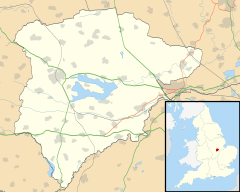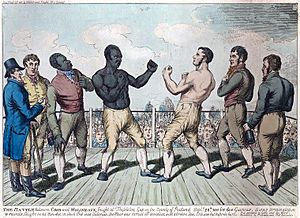Thistleton facts for kids
Quick facts for kids Thistleton |
|
|---|---|
 St Nicholas' Church, Thistleton |
|
| Area | 2.15 sq mi (5.6 km2) |
| Population | 99 2001 Census |
| • Density | 46/sq mi (18/km2) |
| OS grid reference | SK913180 |
| • London | 89 miles (143 km) SSE |
| Unitary authority | |
| Shire county | |
| Ceremonial county | |
| Region | |
| Country | England |
| Sovereign state | United Kingdom |
| Post town | OAKHAM |
| Postcode district | LE15 |
| Dialling code | 01572 |
| Police | Leicestershire |
| Fire | Leicestershire |
| Ambulance | East Midlands |
| EU Parliament | East Midlands |
| UK Parliament |
|
Thistleton is a small village located in the East Midlands of England. It is the most northerly village in the county of Rutland. In 2001, only 99 people lived there. The village's name means 'farm or settlement that has many thistles'.
Thistleton's Ancient History
The area around Thistleton has signs of people living there during Romano-British times. This includes a large area with a temple and possibly a small market town. North of the village, a lot of ironstone has been mined. This type of stone has been used for centuries to build churches and other buildings nearby.
Scientists once thought that the mining had destroyed clues about how big the old Roman settlement was. However, many archaeological finds have shown that the original Roman town covered at least 100 acres. Surveys were done because a road for the quarry was planned to go through the ancient site. These surveys found interesting things like a well-preserved Roman road and the skeleton of a child buried away from the main cemetery. Digging and learning about the past is still happening as the mining continues.
Village Buildings and Church
Thistleton has several important old buildings. These include the Old Rectory and the Church of St Nicholas. Many homes in the village have stone walls and thatched roofs.
The church itself is very old, from the Middle Ages. Only its tower, built in the 1300s, remains from that time. This tower has three levels and features cool stone gargoyles. The rest of the church was rebuilt in the late 1700s by a family called the Brudenells and the local priest. The newer part of the building looks like it's from the 1300s, but its back section is shaped like half an octagon on the outside and a semicircle inside. Most of the things inside the church, like the font (for baptisms) and the organ, are more modern.
Close to the south of the village, you'll find the RAF Cottesmore airfield. It first opened in 1938. Today, this airfield is used by the Army and is known as Kendrew Barracks.
The Famous Boxing Match
On September 28, 1811, a huge crowd of up to 20,000 people gathered at Thistleton Gap. They came to watch a prizefight between two famous boxers. Tom Cribb fought the American Tom Molineaux in a highly anticipated rematch. This fight was for the heavyweight championship of England and was a matter of national pride.
The location was chosen because the counties of Rutland, Leicestershire, and Lincolnshire all meet there. This meant that if the police arrived to stop the illegal fight, the boxers and the crowd could quickly escape into another county. In the eleventh round, Cribb knocked out Molineaux and won the match.
Their first fight, a year earlier, had been very long and tough, lasting 33 rounds. Both men were exhausted, and there were accusations of cheating. Before the rematch, both boxers had lost weight. Cribb trained hard, while Molineaux had lost muscle from fighting in smaller local matches.



